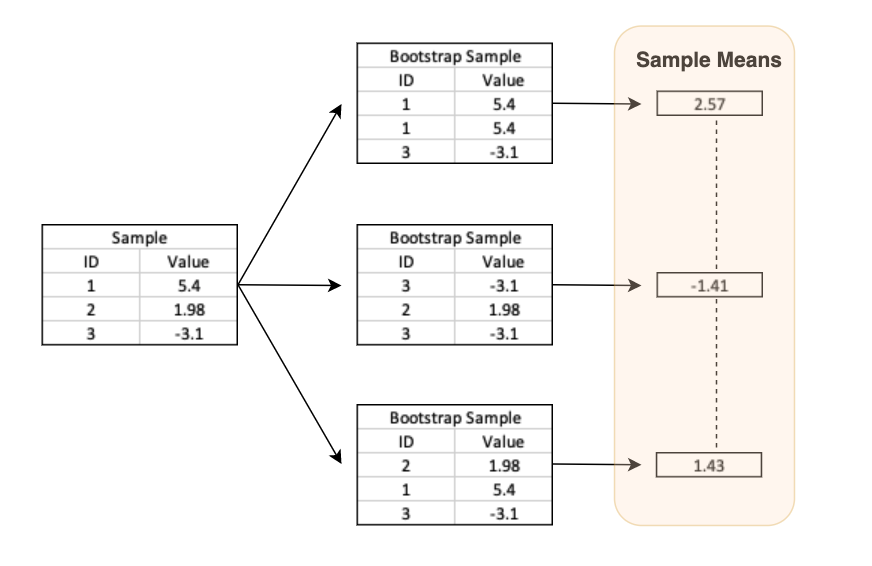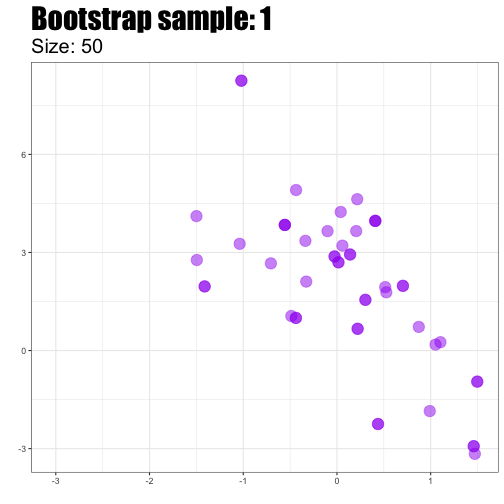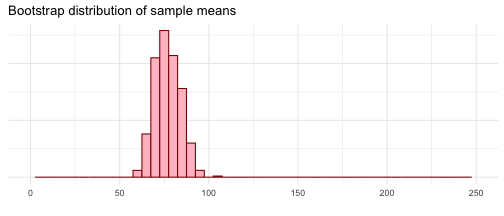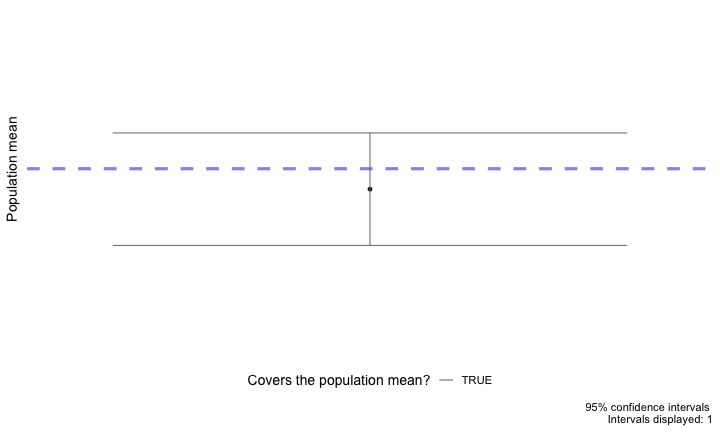Terminology
Population: a group of individuals or objects we are interested in studying
Parameter: a numerical quantity derived from the population (almost always unknown)
Sample: a subset of our population of interest
Statistic: a numerical quantity derived from a sample
| Quantity | Parameter | Statistic |
|---|---|---|
| Mean | μ | ¯x |
| Variance | σ2 | s2 |
| Standard deviation | σ | s |
| Median | M | ~x |
| Proportion | p | ^p |
Statistical inference
Statistical inference is the process of using sample data to make conclusions about the underlying population the sample came from.
Estimation: estimating an unknown parameter based on values from the sample at hand
Testing: evaluating whether our observed sample provides evidence for or against some claim about the population
Today we will focus on estimation.
Point estimate
A point estimate is a single value computed from the sample data to serve as the "best guess", or estimate, for the population parameter.
Suppose we were interested in the population mean. What would be natural point estimate to use?
| Quantity | Parameter | Statistic |
|---|---|---|
| Mean | μ | ¯x |
| Variance | σ2 | s2 |
| Standard deviation | σ | s |
| Median | M | ~x |
| Proportion | p | ^p |
Point estimate
A point estimate is a single value computed from the sample data to serve as the "best guess", or estimate, for the population parameter.
Suppose we were interested in the population mean. What would be natural point estimate to use?
| Quantity | Parameter | Statistic |
|---|---|---|
| Mean | μ | ¯x |
| Variance | σ2 | s2 |
| Standard deviation | σ | s |
| Median | M | ~x |
| Proportion | p | ^p |
What is the downside to using point estimates?
Confidence intervals
A plausible range of values for the population parameter is an interval estimate. One type of interval estimate is known as a confidence interval.


If we report a point estimate, we probably won’t hit the exact population parameter.
If we report a range of plausible values, we have a good shot at capturing the parameter.
Variability of sample statistics
In order to construct a confidence interval we need to quantify the variability of our sample statistic.
For example, if we want to construct a confidence interval for a population mean, we need to come up with a plausible range of values around our observed sample mean.
This range will depend on how precise and how accurate our sample mean is as an estimate of the population mean.
Quantifying this requires a measurement of how much we would expect the sample mean to vary from sample to sample.
Variability of sample statistics
In order to construct a confidence interval we need to quantify the variability of our sample statistic.
For example, if we want to construct a confidence interval for a population mean, we need to come up with a plausible range of values around our observed sample mean.
This range will depend on how precise and how accurate our sample mean is as an estimate of the population mean.
Quantifying this requires a measurement of how much we would expect the sample mean to vary from sample to sample.
Suppose you randomly sample 50 students and 5 of them are left handed. If you were to take another random sample of 50 students, how many would you expect to be left handed? Would you be surprised if only 3 of them were left handed? Would you be surprised if 40 of them were left handed?
Bootstrapping
- The term bootstrapping comes from the phrase "pulling oneself up by one’s bootstraps", to help oneself without the aid of others.
- In this case, we are estimating a population parameter, and we’ll accomplish it using data from only from the given sample.
- This notion of saying something about a population parameter using only information from an observed sample is the crux of statistical inference, it is not limited to bootstrapping.
"The population is to the sample as the sample is to the bootstrap sample" – Fox, 2008
Bootstrapping scheme
Take a bootstrap sample - a random sample taken with replacement from the original sample, of the same size as the original sample.
Calculate the bootstrap statistic - a statistic such as mean, median, proportion, slope, etc. computed from the bootstrap samples.
Repeat steps (1) and (2) many times to create a bootstrap distribution - a distribution of bootstrap statistics.
Calculate the bounds of the XX% confidence interval as the middle XX% of the bootstrap distribution.
Asheville data
Inside Airbnb scraped all Airbnb listings in Asheville, NC, that were active on June 25, 2020.
Population of interest: listings in the Asheville with at least ten reviews.
Parameter of interest: Mean price per guest per night among these listings.
What is the mean price per guest per night among Airbnb rentals in June 2020, among Airbnbs with at least ten reviews in ZIP codes 28801 - 28806?
The dataset asheville.csv contains the price per guest (ppg) for a random
sample of 50 listings.
Point estimate
A point estimate is a single value computed from the sample data to serve as the "best guess", or estimate, for the population parameter. Let's use the sample mean from our dataset in order to do so.
library(tidyverse)abb <- read_csv("data/asheville.csv")abb %>% summarize(mean_price = mean(ppg))#> # A tibble: 1 x 1#> mean_price#> <dbl>#> 1 76.6Is this enough? Are we done? Is there any more insight that can be gained?
CI interpretation
Using the 2.5th and 97.5th quantiles as bounds for our confidence interval gives us the middle 95% of the bootstrap means. Our 95% CI is (65.1, 89.4).
Does this mean there is a 95% chance that the true mean price per night in the population is contained in the interval (65.1, 89.4)?
Interpreting a confidence interval
The population parameter is either in our interval or it isn't. It can't have a "95% chance" of being in any specific interval.
The bootstrap distribution captures the variability of the sample mean, but is based on our original sample. If we obtained a different sample to begin with, (perhaps centered somewhere else), then maybe our estimated 95% confidence interval would have been different also.
Interpreting a confidence interval
The population parameter is either in our interval or it isn't. It can't have a "95% chance" of being in any specific interval.
The bootstrap distribution captures the variability of the sample mean, but is based on our original sample. If we obtained a different sample to begin with, (perhaps centered somewhere else), then maybe our estimated 95% confidence interval would have been different also.
All we can say is that, if we were to independently take repeated samples from this population and calculate a 95% CI for the mean in the exact same way, then we would expect 95% of these intervals to truly cover the population mean. However, we never know if any particular interval(s) actually do!
This is the meaning of statistical confidence.
Warning: Be careful with the concepts of repeatedly re-sampling from the sample to obtain a bootstrap distribution vs. taking a new sample entirely.
Click the link below to create the repository for lecture notes #13.

















